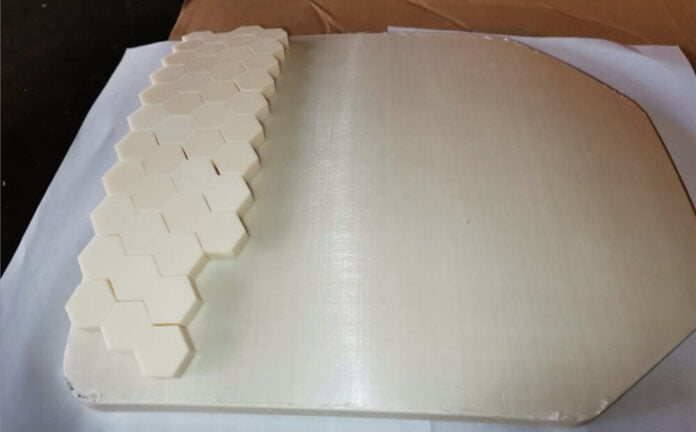Altena Engineering, a prominent German firm specializing in ballistic solutions, opens a window into the intricate world of hard armor manufacturing. Technical Director Mr. Nick Meyer, an experienced technology transfer specialist, shares key insights in an exclusive feature for BodyArmorNews.com.
Crafting Protection: A Step-by-Step Guide to Hard Armor Manufacturing
A composite hard armor plate that protects against armor-piercing rounds, consists in its basic form of two primary components that are bonded together: a ballistic high-strength ceramic and a multi-layer laminate of high-performance fibers.
When hit, the ceramic fractures the projectile upon impact and slows down its remnant, which is then absorbed by the laminated fiber backing.
Raw Materials: Ceramics and Fibers
Ceramics come in two forms, ceramic tiles and monolithic ceramic.
Ceramic tiles are small pieces of ceramic that are assembled in a mosaic to achieve the desired pattern. The advantage of this system is that at impact only a tile and a few neighboring tiles are affected, so the dispersion is restricted. This performs better in a multi-hit scenario. However, gaps between the tiles can be a weakness in this design. Also, a multi-curved version using this system is challenging, so most tile solutions are single-curved. That would be one of the reasons why the demand for this design is lower in Western Europe.
Monolithic ceramic consists of a single piece of ceramic that can be both single-curved and multi-curved. The multi-curved version assures a better fit to the body. The downside of this system is that a projectile impact might crack a larger area of the surface, a multi-hit scenario becoming something difficult to manage without further treatment of the front surface.
The backings for the ceramic consist of multiple layers of prepregs. Prepregs are laminate composites of fiber sheets impregnated with resins that have not been fully cured. In order to bond the prepreg sheets a process of applying heat and pressure must be carried out. The fibers that are often used for this are Aramid or UHMWPE. The sheets are cut in the same pattern as the ballistic plate and stacked together. The number of sheets that are used depends on the desired performance level.
Choosing the Right Process
The bonding of the two main components still has to be carried out. As the critical bonding process determines the efficacy of hard armor plates, the choices made during this procedure are of great importance. There are two approaches that could be taken to finish the hard armor plate, a one-step process, and a two-step process.
For the one-step process, the backing and the ceramic are stacked together and put into an autoclave or vacuum oven. The two-step process consists of first pressing the backing by itself in a hydraulic press, using a heat-pressure cycle, then manually applying the ceramic tiles using a room-temperature hardening adhesive.
It is crucial to choose the right adhesive in order to ensure a long-lasting life cycle of the plate. For the adhesive to properly do its job, the product needs to be repeatedly cleaned in all stages of the process and the climate in which the product is manufactured must be carefully controlled. Close attention to these details will ensure leaving no gaps between the ceramic and backing.
A Final Touch: Protective Covers
The completed plate receives a protective cover, a crucial element for durability and performance.
Traditionally covers are made from a self-adhesive Cordura or other water-repelling nylon fabrics. However, Polyurea coatings become more and more popular, as the PU is simply sprayed or rolled over the whole product.







